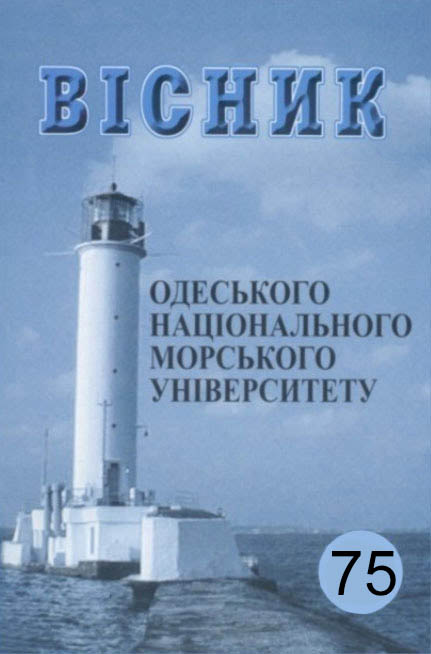Analysis of the human element in the context of the development of marine autonomous surface vessels
Main Article Content
Abstract
The article presents a comprehensive analysis of the role of the human element in the context of the development of Maritime Autonomous Surface Ship (MASS), based on a systematic study of modern scientific publications and practical experience in the implementation of autonomous technologies in the maritime industry. The research is based on a multifactorial analysis of the interaction between humans and automated control systems, including the study of cognitive, psychological and ergonomic aspects of MASS operators. A detailed assessment of existing approaches to classifying the levels of autonomy of marine surface vessels and their impact on navigation safety is carried out, with a special focus on the peculiarities of the work of remote operators and onboard personnel. The paper presents an advanced analysis of statistical data on maritime accidents involving the human element and explores the mechanisms of risk transformation with increasing ship autonomy. Particular attention is paid to the problems of ensuring safety at different levels of autonomy, taking into account the potential risks of collisions, technical failures and cybersecurity threats. The study also covers a set of technological approaches aimed at minimizing the impact of the human element through the introduction of intelligent systems, improvement of adaptive control algorithms, and development of modern communication solutions. Based on the analysis, practical recommendations have been developed to improve personnel training systems, organize effective interaction between operators and automated control systems, and propose methodological approaches to assessing and minimizing risks during MASS operation. The results of the study can be used in the development of regulatory documents, educational programs and safety management systems in the maritime industry, as well as in the design of new generations of autonomous vessels and their control systems.
Article Details
References
2. Li Z., Zhang D., Han B. and Wan C. (2023). Risk and reliability analysis for maritime autonomous surface ship: A bibliometric review of literature from 2015 to 2022. Accident Anal. Prev. 187, 107090. Doi:10.1016/j.aap.2023.107090 [in English].
3. Liu J., Achurra A., Zhang C., Bury A. and Wang X. (2024). A long short term memory network-based, global navigation satellite system/inertial navigation system for unmanned surface vessels. J. Mar. Eng. Technol. 23, Р. 316-328. Doi: 10.1080/20464177.2024.2334029 [in English].
4. Guo M., Zhou X., Guo C., Liu Y., Zhang C. and Bai W. (2024). Adaptive federated filter-combined navigation algorithm based on observability sharing factor for maritime autonomous surface ships. J. Mar. Eng. Technol. 23, Р. 98-112. Doi: 10.1080/20464177.2024.2305721 [in English].
5. Kim M., Joung T.-H., Jeong B. and Park H.-S. (2020). Autonomous shipping and its impact on regulations, technologies, and industries. J. Int. Maritime Safety Environ. Affairs Shipping 4, Р.17-25. Doi: 10.1080/25725084.2020.1779427 [in English].
6. Tao J., Liu Z., Wang X., Cao Y., Zhang M., Loughney S., et al. (2024). Hazard identification and risk analysis of maritime autonomous surface ships: A systematic review and future directions. Ocean Eng. 307, 118174. doi: 10.1016/j.oceaneng.2024.118174 [in English].
7. Torskyi V., Rossomakha O., Oberto Santana L. Systematic risk assessment and management in modern shipping: a comprehensive approach to safety analysis. Monograph. – Primedia eLaunch, Boston, USA, 2024. – 114 p. [in Ukrainian].
8. Fan C., Montewka J., Bolbot V., Zhang Y., Qiu Y. and Hu S. (2024). Towards an analysis framework for operational risk coupling mode: A case from MASS navigating in restricted waters. Reliability Eng. System Saf. 248, 110176. Doi: 10.1016/j.ress.2024.110176 [in English].
9. Johansen, T. and Utne, I. B. (2024). Human-autonomy collaboration in supervisory risk control of autonomous ships. J. Mar. Eng. Technol. 23, 135–153. Doi: 10.1080/20464177.2024.2319369 [in English].
10. Zhou X. Y., Huang J. J., Wang F. W., Wu Z. L. and Liu Z. J. (2020). A study of the application barriers to the use of autonomous ships posed by the good seamanship requirement of COLREGs. J. Navigation 73, Р. 710-725. Doi: 10.1017/s0373463319000924 [in English].
11. International Maritime Organization (2025) «IMO ‒ International Maritime Organization». Available at: https://www.imo.org/ (Accessed: 23 January 2025). [in English].
12. Huang Y. and van Gelder P.H.A.J.M. (2020). Collision risk measure for triggering evasive actions of maritime autonomous surface ships. Saf. Sci. 127, 104708. Doi: 10.1016/j.ssci.2020.104708 [in English].
13. Fan C., Montewka J. and Zhang D. (2022). A risk comparison framework for autonomous ships navigation. Reliability Eng. System Saf. 226, 108709. Doi: 10.1016/j.ress.2022.108709 [in English].
14. Fan C., Bolbot V., Montewka J. and Zhang D. (2024a). Advanced Bayesian study on inland navigational risk of remotely controlled autonomous ship. Accident Anal. Prev. 203, 107619. Doi: 10.1016/j.aap.2024.107619 [in English].
15. Wróbel K., Montewka J. and Kujala P. (2017). Towards the assessment of potential impact of unmanned vessels on maritime transportation safety. Reliability Eng. System Saf. 165, 155-169. doi: 10.1016/j.ress.2017.03.029 [in English].
16. Hassani V., Crasta N., and Pascoal A. (2017). Cyber Security Issues in Navigation Systems of Marine Vessels From a Control Perspective (Trondheim, Norway: The American Society of Mechanical Engineers (ASME)), 2017 V07BT06A029 [in English].
17. Lager M. and Topp E.A. (2019). Remote supervision of an autonomous surface vehicle using virtual reality. IFAC-PapersOnLine 52, Р. 387-392. Doi: 10.1016/j.ifacol.2019.08.104 [in English]
18. Chae C.-J., Kim M. and Kim H.-J. (2020). A study on identification of development status of MASS technologies and directions of improvement. Appl. Sci. 10, 4564. Doi: 10.3390/app10134564 [in English].
19. Longo G., Martelli M., Russo E., Merlo A. and Zaccone R. (2023). Adversarial waypoint injection attacks on Maritime Autonomous Surface Ships (MASS) collision avoidance systems. J. Mar. Eng. Technol. 23 (3), Р. 184-195. Doi: 10.1080/20464177.2023.2298521 [in English].
